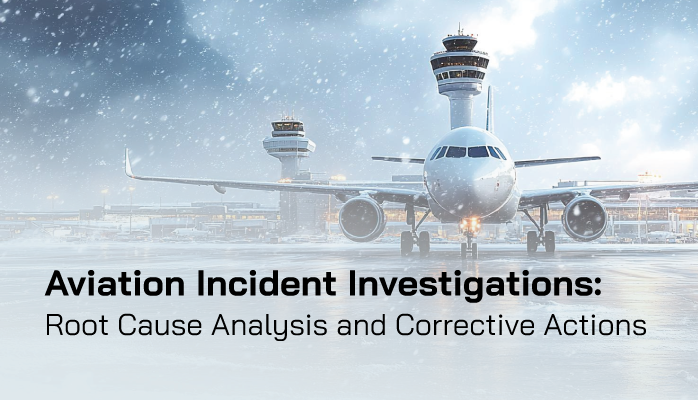How to Conduct Root Cause Analysis

Aviation safety is paramount, and for safety managers, conducting thorough incident investigations is a critical responsibility.
Whether addressing accidents or near-misses, understanding the root causes and implementing effective corrective actions can prevent future occurrences and enhance safety protocols. This article explores the importance of incident investigations, the role of root cause analysis (RCA), and the steps to develop corrective actions that ensure a safer aviation environment.
Why Incident Investigations Matter in Aviation
Aviation incidents, whether accidents or near-misses, pose significant risks to
- personnel,
- passengers,
- assets and
- the environment.
According to the International Civil Aviation Organization (ICAO), thorough investigations are essential for identifying systemic issues and preventing recurrence. Safety managers play a pivotal role in ensuring investigations are comprehensive, objective, and actionable.
Investigations serve multiple purposes:
-
Identify Causes: Pinpoint the immediate and underlying causal factors contributing to an incident.
-
Prevent Recurrence: Implement control measures to address root causes and mitigate risks.
-
Enhance Safety Culture: Foster a proactive approach to safety by learning from incidents.
-
Regulatory Compliance: Meet requirements set by aviation authorities like the FAA or EASA.
By prioritizing incident investigations, safety managers can uphold operational integrity and protect stakeholders.
The Role of Root Cause Analysis (RCA) in Incident Investigations
Root Cause Analysis (RCA) is a structured method used to identify the underlying reasons an incident occurred. Unlike superficial assessments that address only immediate causes, RCA digs deeper to uncover systemic issues, human factors, and procedural deficiencies.
SMS Pro contains user-friendly database tools to walk safety teams through the root cause process during safety investigations. SMS database software offers considerable power in aviation safety risk management workflows.
Key Benefits of RCA
-
Comprehensive Understanding: RCA reveals not just what happened but why it happened.
-
Systemic Improvements: By addressing root causes, organizations can implement lasting solutions.
-
Data-Driven Decisions: RCA provides evidence-based insights for corrective actions.
-
Proactive Safety: Identifying potential risks before they lead to further incidents.
Common RCA Methodologies
Several RCA methodologies are effective in aviation incident investigations:
-
5 Whys: Repeatedly asking "why" an issue occurred to drill down to the root cause.
-
Fishbone Diagram (Ishikawa): Categorizing causes into factors like people, processes, equipment, and environment.
-
Fault Tree Analysis (FTA): Mapping out logical relationships between events and failures.
-
Human Factors Analysis and Classification System (HFACS): Focusing on human error and organizational influences.
SMS Pro includes three of these methodologies for conducting incident investigations. For example, if a near-miss involves a runway incursion, the 5 Whys might reveal that inadequate training, combined with unclear communication protocols, contributed to the incident. This insight guides efficient corrective action development and helps prevent recurring incidents.
Related Articles on Using Fishbone Diagrams in Aviation SMS
- How to Use Fishbone Diagrams in Aviation SMS - Walkthrough
- Pros and Cons of Fishbone Diagrams in Aviation SMS
- 5 Steps to Create Fishbone Diagrams in Aviation SMS
Steps for Conducting an Effective Incident Investigation

A structured approach ensures investigations are thorough and yield actionable outcomes. Here’s a step-by-step guide for aviation safety managers:
1. Secure the Incident Scene
Immediately after an incident, secure the site to preserve evidence. Restrict access, document conditions (e.g., weather, equipment status), and collect physical evidence like flight data recorders or maintenance logs.
2. Gather Data and Evidence
Collect comprehensive data, including:
-
Witness Statements: Interview crew, ground staff, and other relevant personnel.
-
Operational Records: Review flight logs, maintenance records, and air traffic control communications.
-
Environmental Factors: Assess weather, runway conditions, or visibility.
-
Technology Data: Analyze black box data, radar tracks, or avionics systems.
3. Form an Investigation Team
Assemble a multidisciplinary team, including safety officers, pilots, engineers, and human factors specialists. Ensure team members are trained in RCA and familiar with aviation regulations.
4. Perform Root Cause Analysis
Apply an RCA methodology to analyze data. For instance, using a Fishbone Diagram, categorize causes under headings like "Training," "Equipment," or "Procedures." Identify both immediate causes (e.g., pilot error) and underlying factors (e.g., inadequate fatigue management policies).
5. Develop Corrective Actions
Based on RCA findings, propose corrective actions that are:
-
Specific: Clearly address identified root causes.
-
Measurable: Include metrics to evaluate effectiveness.
-
Achievable: Feasible within organizational constraints.
-
Relevant: Aligned with safety goals.
-
Time-Bound: Set deadlines for implementation.
6. Document and Report Findings
Create a detailed report outlining the incident, RCA results, and recommended actions. Share findings with stakeholders, including regulatory bodies, to ensure transparency and compliance.
7. Implement and Monitor Corrective Actions
Execute corrective actions promptly and monitor their effectiveness. For example, if inadequate training was a root cause, conduct refresher courses and track performance metrics to confirm improvements.
8. Foster a Learning Culture
Share lessons learned across the organization. Conduct safety briefings, update training programs, and integrate findings into risk management strategies to prevent similar incidents.
Related Articles on Aviation SMS Lessons Learned Library
- How Mistakes Improve Aviation SMS Processes
- 6 Lessons Every Aviation SMS Program Can Learn From Star Wars
Examples of Corrective Actions for Common Aviation Incidents
To illustrate, here are corrective actions for typical aviation incidents based on RCA findings:
Incident: Runway Incursion (Near-Miss)
- Root Cause: Poor communication between air traffic control and pilots.
- Corrective Actions:
- Implement standardized phraseology training for pilots and controllers.
- Install enhanced runway incursion warning systems.
- Conduct regular joint simulations for ATC and flight crews.
Incident: Maintenance Error Leading to Equipment Failure
- Root Cause: Lack of adherence to maintenance checklists.
- Corrective Actions:
- Introduce digital checklists with mandatory verification steps.
- Enhance technician training on critical systems.
- Audit maintenance processes quarterly.
Incident: Controlled Flight Into Terrain (Accident)
- Root Cause: Inadequate crew resource management (CRM) and situational awareness.
- Corrective Actions:
- Revamp CRM training to emphasize decision-making under stress.
- Upgrade avionics with terrain awareness and warning systems (TAWS).
- Mandate recurrent simulator training for high-risk scenarios.
Challenges in Incident Investigations and How to Overcome Them

Aviation safety managers may encounter challenges during investigations, including:
- Data Gaps: Incomplete records or missing evidence. Solution: Use redundant data sources like ATC recordings or crew debriefs.
- Blame Culture: Fear of punishment may discourage honest reporting. Solution: Promote a just culture that prioritizes learning over blame.
- Resource Constraints: Limited time or expertise. Solution: Leverage external consultants or RCA software tools.
- Regulatory Pressure: Balancing compliance with thoroughness. Solution: Align investigations with ICAO Annex 13 standards to meet regulatory expectations.
The Role of Technology in Enhancing Investigations
Modern technology streamlines incident investigations and improves accuracy:
- Flight Data Monitoring (FDM): Analyzes flight parameters to identify trends and anomalies.
- Drones: Capture aerial footage of incident sites for detailed analysis.
- AI and Machine Learning: Predict potential risks by analyzing historical incident data.
- RCA Software: Tools like SMS Pro's Issue Manager, TapRooT or Cause Mapping simplify root cause identification.
By integrating these technologies, safety managers can enhance the efficiency and effectiveness of investigations.
Related Aviation Safety Software Articles
- How to Choose Aviation SMS Software - Educating SMS Professionals
- How Does Aviation Safety Software Improve Safety?
- 20 Benefits of Aviation SMS Software
Building a Proactive Safety Culture
Incident investigations are not just about reacting to events but also about preventing them. Safety managers should:
-
Conduct regular safety audits to identify risks before incidents occur.
-
Encourage anonymous reporting of near-misses to capture valuable data.
-
Invest in recurrent training to keep staff updated on best practices.
-
Collaborate with industry peers to share insights and adopt proven strategies.
A proactive safety culture, supported by robust investigations, ensures that aviation organizations stay ahead of risks.
Conclusion
For aviation safety managers, incident investigations are a cornerstone of operational excellence. By leveraging Root Cause Analysis and implementing targeted corrective actions, managers can address the underlying causes of accidents and near-misses, preventing recurrence and enhancing safety.
A structured approach, combined with modern technology and a proactive safety culture, empowers organizations to uphold the highest safety standards. By learning from every incident, aviation professionals can ensure safer skies for all.
Call to Action: Review your organization’s incident investigation processes today. Are you using RCA effectively? Are corrective actions yielding results? Take steps to strengthen your safety framework and protect your operations.
Do you need modern RCA tools? We can help. Contact us today to learn more.







